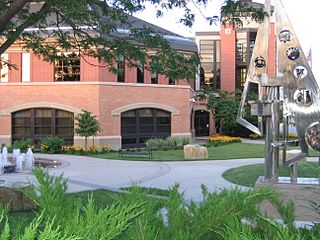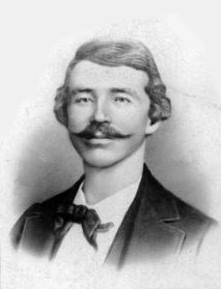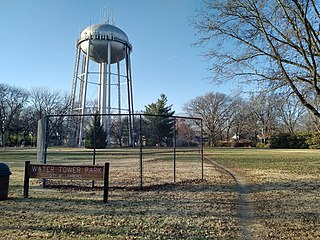Related Research Articles

Olathe is the county seat of Johnson County, Kansas, United States. It is the fourth-most populous city in the Kansas City metropolitan area and Kansas, with a 2020 population of 141,290.

William Clarke Quantrill was a Confederate guerrilla leader during the American Civil War.

The Battle of Baxter Springs, more commonly known as the Baxter Springs Massacre, was a minor battle of the American Civil War fought on October 6, 1863, near the present-day town of Baxter Springs, Kansas.

The Lawrence massacre, also known as Quantrill's raid, was an attack during the American Civil War (1861–65) by Quantrill's Raiders, a Confederate guerrilla group led by William Quantrill, on the Unionist town of Lawrence, Kansas, killing around 150 men and boys.
Fort Baxter, also known as Fort Blair, was a small US Army post located in the southeast corner of Kansas near present-day Baxter Springs. This area was known as the Cherokee Strip. It was one of a few Kansas forts attacked by Confederate forces during the American Civil War. At one point the Confederate government claimed authority over the Neutral Lands. Both Union and Confederate troops operated in the area, as did guerrilla forces and militias prevalent in the Kansas-Missouri border area.
Kansas has always been home to many forts and military posts.
Barnesville's Post located near Barnesville, in Bourbon County, Kansas, was the site of military camps for stretches of time during the American Civil War. The first mention of a camp there came from a report written on September 4, 1861, by Sen. James Lane. This was during the time Lane had evacuated Fort Scott and moved his forces to areas north of that post. A post was established at Barnesville. Lane wrote to Capt. W. E. Prince, then commanding Fort Leavenworth, "I am holding Barnesville. .. with an irregular force of about 250 men, stationed in log buildings, and am now strengthening their position with earth entrenchments."
In early May 1863 a temporary camp, Camp Hooker, was established at the site of what later became Baxter Springs, Kansas. This area was located in what was known as the Cherokee Strip (Kansas). In late May while the camp commander, Col. James M. Williams, was in Fort Scott, the troops moved the camp three blocks to the east to what is now Washington School Hill. The new camp, Camp Ben Butler (named after Maj. Gen. Benjamin Butler, was in a highly defendable position. It occupied a plateau that covered more than two square blocks. Only a small area to the south allowed easy access to camp. In fact, much of the surrounding area was practically impenetrable by men or horses.

Lawrence, Kansas was not well defended in the early part of the Civil War. That ended with William Quantrill's devastating guerrilla raid August 21, 1863. By early 1864 Union soldiers were permanently camped on the top and slopes of Mount Oread, then to Lawrence's southwest. It seems the camp was originally named Camp Ewing, after Brig. Gen. Thomas Ewing.
Camp Hunter was established in June 1862 or a bit earlier at what is now Baxter Springs, Kansas. It was established by Union troops. At the same time Indian Home Guard regiments established a camp nearby on Little Five Mile Creek.
In June 1862 two Union camps were established in the vicinity of what is today Baxter Springs, Kansas. One was Camp Hunter, located in what is now the center of the town. The other was the Indian Home Guard Camp, located at Little Five Mile Creek, 1½ miles southeast of Camp Hunter.
During the Civil War, Coldwater Grove existed 13½ miles east of Paola, Kansas, in Miami County. It straddled the Kansas-Missouri border, being partly in both states. About June 1863 a Union military post was established on the Kansas side of the community and the post was put under the command of Lt. Col. Charles S. Clark. Clark also commanded four nearby posts.
In 1864 Gen. Samuel R. Curtis established a military camp at the Fort Riley-Fort Larned Road crossing of the Smokey Hill River in what is now Ellsworth County, Kans.
Fort McKean is a fort located inside Kansas along the Kansas-Missouri border. On November 14, 1862, Company C of the 3rd Wisconsin Cavalry, led by Lieut. James B. Pond, established a camp at Morris Mills on Drywood Creek. It was fifteen miles southeast of Fort Scott. Sometime later this camp was given the name of Fort McKean. The post was probably on the Fort Scott-Fort Gibson Military Road, and many, including Pond, thought the post was inside Missouri. Throughout its history, Fort McKean was a small post, ranging in strength from 20 to 60 men. It is unknown what buildings or defenses were erected there.
The Lawrence blockhouses were a series of blockhouses built in the spring of 1864 in Lawrence, Kansas, to provide defensive structures in case of attack by Confederate guerrillas. On August 21, 1863, Lawrence had been attacked by 400 guerrillas and Confederate Army recruits under the command of William C. Quantrill. Lawrence was caught virtually defenseless and much of the town was destroyed and about 180 men and boys were killed, most of them defenseless. A militia became active by spring 1864 to prevent another attack.
Mound City's post was established by 1860 in Mound City, Kansas. In August 1861 U.S. Senator James H. Lane reported to the commander of Fort Leavenworth that the post was to be fortified. In fact, Mound City's post became one of the important posts guarding against Confederate guerrilla attacks along the Kansas-Missouri border. Through the War usually 200 to 300 troops at a time were stationed at the post.
Osage Mission's post was located at the Osage Catholic Mission, which was established in 1847. Eventually, Osage Mission became the town of St. Paul, Kansas, inside what would become Neosho County, Kansas. The Mission was located about 35 miles (56 km) north of the Kansas-Indian Territory border. Indian Territory eventually became the state of Oklahoma. When the Civil War erupted, Father John Schoenmakers wanted to keep the Mission as neutral ground and thus out of the conflict. Although at one point Schoenmakers had to flee for a time, he pretty much succeeded in keeping Osage Mission itself out of harm's way.
Paola's post, sometimes called Post Paola, in Miami County, Kansas, was located on the west side of Bull Creek, just west of Paola, Kansas. It was probably established in December 1861, as that was the first time it was mentioned. This post became one of the more important posts along the Kansas-Missouri border during the Civil War. It became a district headquarters in 1863. Later, in September 1864, it was designated a subdistrict headquarters, when the district headquarters was moved to Lawrence, Kansas. The military road from Fort Leavenworth to Fort Gibson ran through Paola, thus ensuring the post always had some importance.
Rockville's post, in southern Miami County, Kansas, was established at the small town of Rockville, Kansas, founded in 1859 by those loyal to the southern cause in Kansas. The other side, the free-staters, soon gained control of the town and it was loyal to the Union when the Civil War broke out in 1861. Rockville was located on the top of a hill surrounded by rolling plains. During the American Civil War, the area was almost bare of trees, allowing troops holding the town to see anyone coming from some distance away. Rockville's post was one of the many posts established in the War to help guard the Kansas-Missouri border area.
The Salina Stockade was built in Salina, Kansas, to provide the residents with protection from the American Indians in the area, many of whom were hostile toward white settlement. Salina had been raided in 1862 by Native Americans and then Confederate guerrillas, but it was not until May 1864 when residents decided they needed to build a stockade for protection. On May 17, 1864, a makeshift stockade, consisting of wagons placed in a circle around the town's flagpole, was erected. The local militia then drilled and guarded Salina. On the northeast corner of 7th Street and Iron Avenue stood a small building. Around this a permanent stockade was erected in May and June 1864.
References
- ↑ William C. Pollard, Jr., "Forts and Military Posts in Kansas: 1854-1865" (Ph.D. dissertation, Faith Baptist College and Seminary, 1997), p. 8; William E. Connelley, Quantrill and the Border Wars, 1956 ed. (New York: Pageant Book Co., 1956), pp. 225-8.
- ↑ Connelley, pp. 234-5; Col. Robert H. Graham, report, The War of the Rebellion (Washington: Government Printing Office, 1883), Series I, Vol. VIII, pp. 335-6; Oliver H. Gregg, "History of Johnson County, Kansas," Atlas Map of Johnson County, Kansas (Wyandotte, Kans,: E. F. Heisler & Co., 1874), p. 31.
- ↑ Untitled letter, The Independent (Oskaloosa), August 15, 1863, p. 2; Connelley, pp. 315-6; Capt. Charles F. Coleman, report, The War of the Rebellion (Washington: Government Printing Office, 1888), Series I, Vol. XXII, Part I, p. 590; Brig, Gen. Thomas Ewing, report, The War of the Rebellion (Washington: Government Printing Office, 1888), Serive I, Vol. XXII, Part I, p. 580.
- ↑ Coleman, p. 590; Ewing, p. 580; "Organization of troops in the Department of the Missouri, commanded by Maj. Gen. John M. Schofield, December 31, 1863," The War of the Rebellion (1888), Series I, Vol. XXII, Part II, p. 762; Col. Edward Lynde, report, The War of the Rebellion (1891), Series I, Vol. XXXIV, Part II, p. 274; Asst. Adjutant Gen. George S. Hampton, report, The War of the Rebellion (1891), Series I, Vol. XXXIV, Part II, p. 352; "Troops in the Department of Kansas, Maj. Gen. Samuel R. Curtis, U.S. Army, commanding, June 30, 1864," The War of the Rebellion (1891), Series I, Vol. XXXIV, Part IV, p. 622; "One of the Gang," Kansas Daily Tribune (Lawrence), July 30, 1864, p. 3; Hampton, report, The War of the Rebellion (1893), Series I, Vol. XLI, Part III, pp. 259-60.
- ↑ Hampton, report, The War of the Rebellion (Washington: Government Printing Office, 1893), Series I, Vol. XLI, Part III, pp. 259-60; "Another Raid," The Olathe Mirror, February 4, 1865, p. 2; "Protection," The Olathe Mirror, February 11, 1865, p. 2; Capt. A. J. Lumsden, report, The War of the Rebellion (1896), Series I, Vol. XLVIII, Part II, p. 337.